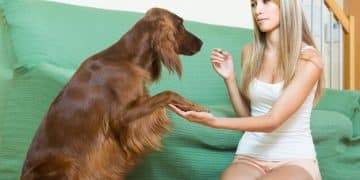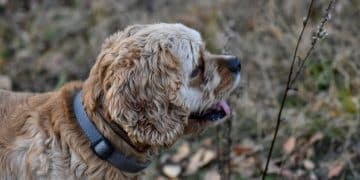Resource Guarding Rehab: Safely Addressing Food & Toy Aggression
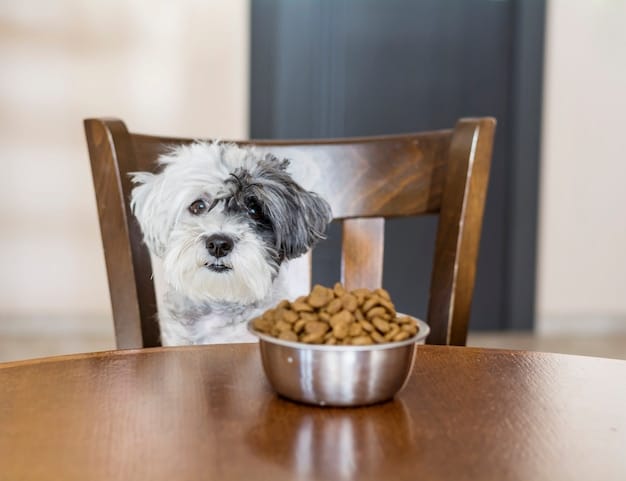
Anúncios
Resource guarding rehab involves a systematic approach to modify a dog’s behavior when they exhibit possessiveness over food or toys, using positive reinforcement techniques to create a sense of security and trust, ultimately reducing aggressive tendencies.
Discovering that your beloved canine companion has a tendency to guard their food or toys can be a challenging experience. Resource guarding rehab: safely address food & toy aggression is not only possible but also essential for maintaining a harmonious household and ensuring the safety of everyone involved.
Anúncios
Understanding Resource Guarding in Dogs
Resource guarding is a common behavioral issue in dogs, characterized by a dog’s attempt to retain possession of certain items by displaying behaviors that range from subtle warnings to overt aggression. Recognizing the signs and understanding the underlying causes are crucial first steps.
What Triggers Resource Guarding?
Several factors can contribute to the development of resource guarding. These triggers often relate back to a dog’s perception of scarcity or fear of losing something valuable to them.
Anúncios
- Genetics and Predisposition: Some dogs may be genetically predisposed to guarding behaviors.
- Past Experiences: Previous experiences, like having to compete for food or toys, can create anxiety around resources.
- Perceived Value: The perceived value of an item influences how intensely a dog will guard it. High-value items like bones or special toys are more likely to be guarded.
- Lack of Trust: If a dog doesn’t fully trust their environment or the people around them, they are more likely to guard resources.
Identifying the specific triggers for your dog will help you tailor your resource guarding rehab strategy effectively.
Recognizing the Signs of Resource Guarding
Early recognition of resource guarding behavior is important to prevent escalation. Signs can be subtle at first, gradually increasing in intensity.
- Stiffening of Body: Your dog might become rigid when someone approaches their food or toy.
- Eating Faster: They may quickly gulp down food to prevent anyone from taking it away.
- Growling or Snapping: An obvious warning sign that indicates the dog is uncomfortable and feels threatened.
- Showing Teeth: A more intense warning, signifying that the dog is ready to defend the resource.
Understanding these signs allows you to intervene and manage the situation before it escalates into a more aggressive display.
In conclusion, recognizing the triggers and signs of resource guarding provides a foundation for developing a successful rehab strategy. Awareness and early intervention are key to modifying this behavior and ensuring your dog feels secure.
Creating a Safe Environment for Rehab
Creating a secure and predictable environment is essential for starting resource guarding rehab. A safe environment helps reduce the dog’s anxiety and builds trust, making them more receptive to training.
Establishing Trust Through Predictability
Dogs thrive on routine and predictability. Consistency in daily activities helps them feel secure and reduces stress.
- Consistent Feeding Schedule: Feed your dog at the same times each day.
- Dedicated Feeding Area: Choose a quiet, low-traffic area where your dog can eat undisturbed.
- Minimize Disturbances: Avoid approaching or touching your dog while they are eating, especially during the initial stages of rehab.
By providing a predictable routine, you are creating a safe space where your dog feels confident and less likely to engage in resource guarding behaviors.
Managing High-Value Items
High-value items, such as bones or favorite toys, often trigger intense guarding behaviors. Managing these items carefully can prevent escalation.
- Controlled Access: Limit access to high-value items, especially when you can’t supervise your dog.
- Trading Up: Practice trading the item for something even more appealing, like a tasty treat. This teaches your dog that giving up the item leads to a positive outcome.
- Gradual Introduction: Reintroduce high-value items slowly, rewarding calm behavior and willingness to share.
Effectively managing high-value items reduces the likelihood of guarding incidents and promotes a more relaxed attitude towards sharing.
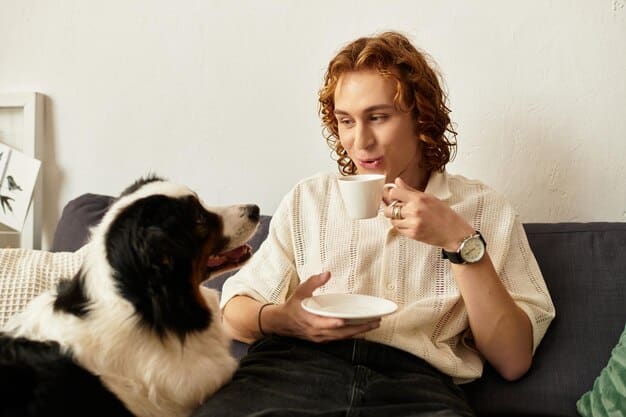
In summary, creating a safe environment involves establishing predictability and carefully managing high-value items. These measures reduce anxiety, build trust, and set the stage for successful resource guarding rehab.
Positive Reinforcement Techniques for Resource Guarding
Positive reinforcement is a key component of resource guarding rehab. These techniques focus on rewarding desired behaviors rather than punishing unwanted ones, creating a positive association with sharing and reducing anxiety.
The “Add-In” Method
The “add-in” method involves approaching your dog while they are eating and adding something extra delicious to their bowl. This teaches them that your approach is a positive event.
For example, start by adding a small piece of chicken or cheese to their food bowl while they are eating. Over time, gradually approach closer and add the treat. The goal is to associate your presence with positive experiences, making them less likely to guard their resources.
Trading Games
Trading games teach your dog that giving up an item results in receiving something even better. This builds a positive association with sharing and reduces possessiveness.
Start with low-value items and gradually work up to higher-value objects. When your dog has a toy, offer them a tasty treat in exchange. As they drop the toy to take the treat, praise them and give them the treat. Consistently rewarding this behavior reinforces the idea that giving up an item is a good thing.
Desensitization and Counterconditioning
Desensitization involves gradually exposing your dog to the triggers that cause resource guarding, while counterconditioning aims to change their emotional response to those triggers.
- Start at a Distance: Begin by standing far away from your dog while they are eating, and reward calm behavior.
- Gradual Approach: Slowly decrease the distance between you and your dog, continuing to reward calmness.
- Positive Association: Pair your approach with positive reinforcement, such as adding high-value treats to their bowl.
These techniques gradually change your dog’s perception of your approach from a threat to a positive event, reducing the urge to guard their resources.
In conclusion, positive reinforcement techniques, such as the “add-in” method, trading games, and desensitization, are effective tools for resource guarding rehab. By creating positive associations and rewarding desired behaviors, you can help your dog feel more secure and less possessive.
Managing Setbacks and Aggressive Behaviors
During resource guarding rehab, setbacks are normal. Knowing how to manage these situations, especially if they involve aggressive behaviors, is crucial to ensuring safety and progress.
Recognizing and Reacting to Warning Signs
Identifying early warning signs of resource guarding can help you de-escalate the situation before it becomes aggressive.
- Stiff Body Language: If your dog’s body becomes rigid, it’s a sign they are becoming uncomfortable.
- Lip Licking or Yawning: These can be subtle signs of stress or anxiety.
- Growling: A clear warning that the dog is feeling threatened.
When you notice these signs, immediately create distance by backing away and stopping whatever you were doing that triggered the behavior. Avoid direct eye contact and speak calmly to reassure your dog.
What to Do During Aggressive Episodes
If your dog displays aggressive behaviors, such as snapping or biting, it’s important to handle the situation carefully to prevent further escalation.
- Stay Calm: Avoid yelling or making sudden movements, as this can worsen the situation.
- Create Distance: If possible, create distance between you and your dog. Use a barrier if necessary.
- Seek Professional Help: Consult with a certified dog trainer or veterinary behaviorist.
In more aggressive episodes, it’s better to cease the activity and reassess your tactics. It is crucial to consult with a professional for guidance.
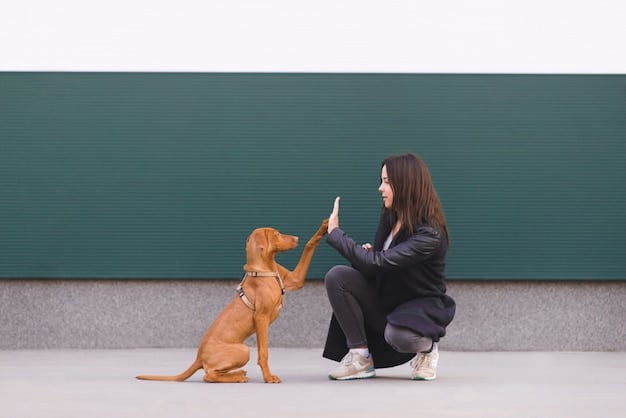
Preventing Future Setbacks
Preventing future setbacks involves carefully managing your dog’s environment and consistently reinforcing positive behaviors.
- Consistent Training: Continue practicing positive reinforcement techniques regularly.
- Avoid Pressure: Do not force your dog into situations that trigger resource guarding.
- Manage Resources: Always supervise access to high-value items and continue practicing trading games.
By consistently reinforcing positive behaviors and carefully managing your dog’s environment, you can minimize the risk of future setbacks and help your dog feel more secure.
In summary, managing setbacks and aggressive behaviors during resource guarding rehab requires vigilance, caution, and consistency. Recognizing warning signs, knowing how to react during aggressive episodes, and preventing future setbacks are essential for ensuring safety and promoting progress.
The Role of Diet and Exercise in Managing Resource Guarding
While training is crucial, diet and exercise also play a significant role in managing resource guarding rehab. A balanced diet and regular exercise contribute to a dog’s overall well-being, reducing anxiety and promoting a more relaxed demeanor.
The Impact of Nutrition on Behavior
A poor diet can negatively affect a dog’s behavior, leading to increased anxiety and reactivity.
- Balanced Nutrients: Ensure your dog’s diet is balanced with essential nutrients, including proteins, fats, and carbohydrates.
- Avoid Additives: Limit processed foods and those with artificial additives, as these can contribute to hyperactivity and anxiety.
- Omega-3 Fatty Acids: Incorporate omega-3 fatty acids, which have been shown to reduce anxiety and aggression in dogs.
A well-nourished dog is more likely to be calm and receptive to training, making resource guarding rehab more effective.
The Importance of Regular Exercise
Exercise is a vital component of a dog’s mental and physical health. Regular physical activity helps reduce stress, burn excess energy, and promote calmness.
- Daily Walks: Take your dog for daily walks to provide mental stimulation and physical exertion.
- Playtime: Engage in interactive play sessions, such as fetch or tug-of-war, to burn energy and strengthen your bond.
- Puzzle Toys: Use puzzle toys to provide mental stimulation and keep your dog entertained, reducing boredom-related anxiety.
A well-exercised dog is less likely to exhibit resource guarding behaviors due to reduced stress and increased overall well-being.
In conclusion, diet and exercise are important factors in managing resource guarding rehab. A balanced diet and regular physical activity contribute to a dog’s overall well-being, reducing anxiety and promoting a more relaxed demeanor, which enhances the effectiveness of training efforts.
When to Seek Professional Help
While many cases of resource guarding rehab can be managed at home, there are situations where seeking professional help is necessary. Recognizing when to consult a certified dog trainer or veterinary behaviorist is crucial for ensuring the safety and well-being of everyone involved.
Signs That Professional Intervention Is Needed
Several signs indicate that professional intervention is warranted.
- Severe Aggression: If your dog displays severe aggression, such as biting or lunging, professional help is essential.
- Lack of Progress: If you have been consistently implementing training techniques without seeing improvement, it may be time to seek expert guidance.
- Anxiety or Fear: If your dog exhibits significant anxiety or fear related to resource guarding, a professional can help address these underlying issues.
Professional help ensures the dog is taught the correct and appropriate behavior for its breed and environmental circumstances.
Finding the Right Professional
Choosing the right professional is important for successful resource guarding rehab. Look for certified dog trainers or veterinary behaviorists with experience in addressing resource guarding.
- Certification: Ensure the trainer is certified by a reputable organization.
- Experience: Ask about their experience working with resource guarding cases.
- Methods: Inquire about their training methods and ensure they align with positive reinforcement principles.
Consulting with a professional provides access to expert guidance, customized training plans, and strategies tailored to your dog’s specific needs.
In summary, knowing when to seek professional help is important for successful resource guarding rehab. If your dog exhibits severe aggression, lacks progress with training, or shows significant anxiety, consulting a certified dog trainer or veterinary behaviorist can provide the expertise and support needed to address these challenges effectively.
| Key Point | Brief Description |
|---|---|
| 🛡️ Understanding Triggers | Identify what causes resource guarding in your dog. |
| 🍎 Positive Reinforcement | Use treats and praise to reward desired behaviors. |
| 🧘 Safe Environment | Create a secure and predictable space for your dog. |
| 🐶 Professional Help | Know when to consult a certified trainer or behaviorist. |
Frequently Asked Questions
▼
Resource guarding is when a dog protects items they value, like food or toys, by showing possessive behaviors such as growling, snapping, or biting to prevent others from approaching.
▼
Use positive reinforcement techniques like trading high-value items for even better treats. Create a safe, predictable environment, and seek professional help if needed.
▼
Yes, it can be. It can escalate into aggression if not addressed, posing risks to people and other animals. Early intervention and training can help manage and reduce the behavior.
▼
Early signs include stiffening of the body, eating faster, guarding the item with their body, or subtle lip licking when someone approaches their valued item.
▼
Yes, diet can indirectly affect behavior. A balanced diet supports overall health and can help reduce anxiety. Avoid artificial additives that may contribute to hyperactivity and stress.
Conclusion
Resource guarding can be a challenging behavior to address, but with patience, consistency, and the right techniques, resource guarding rehab is possible. By understanding the triggers, creating a safe environment, using positive reinforcement, and consulting professionals when needed, you can help your dog feel more secure and less possessive, fostering a happier and safer home for everyone.




